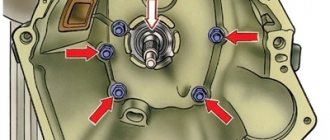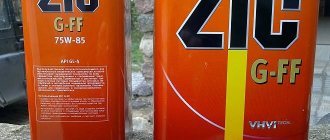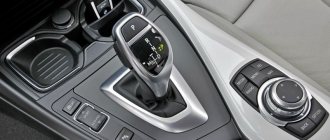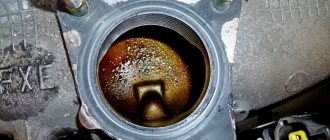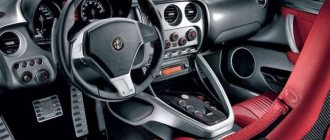The automotive industry is rapidly improving the design of key components and assemblies, making life easier for drivers and improving the technical characteristics of vehicles. More and more modern cars are abandoning manual transmissions, giving preference to new and more advanced transmissions: automatic, robotic and CVT.
In the article we will look at the types of gearboxes, how they differ from each other, how they work, the principle of operation and the degree of reliability.
What does a gearbox do?
The gearbox is one of the most important components of a car. In many ways, the impression of owning a car depends on it. The presence of jerks during acceleration and high fuel consumption spoil the lives of many motorists. At one time, problems with DSG and Powershift gearboxes significantly spoiled the reputation of the Volkswagen and Ford brands. And for many motorists, a robotic gearbox is an evil that is best avoided. In fact, each type of gearbox has its own pros and cons. The main thing is to understand for what purpose you are purchasing a car. Then everything will fall into place.
Main disadvantages of automatic transmission
- "Classical"
- High cost of production, which affects the price of the car as a whole.
- Compared to mechanics, the risk of breakdown is higher.
- The dynamic properties of a car and its efficiency directly depend on the success of a particular modification of the box and the year of its creation. Boxes of early releases increased fuel consumption and reduced dynamics.
- It is absolutely impossible to start the car “from the pusher”, since it requires mass pressure in the system and a working oil pump.
- Robot boxes
- When driving aggressively, driving discomfort occurs.
- Preselective boxes are more expensive than any other.
- Not resistant to slipping.
- At the beginning of the movement, you need to be prepared for a rollback.
- Gear shift delays often occur.
- Doesn't work correctly if you make mistakes while driving.
- Lower resource than the “classic” type.
- When transferring from another type of gearbox, an adaptation period and a process of adjusting your driving style may be required.
- CVT
- High cost of production.
- Expensive repairs and maintenance.
- Compared to hydraulics, maintenance needs to be done twice as often.
- Low resource of the main mechanism of the variator, 120 thousand kilometers.
- Does not fit well with powerful and large engines, more powerful than 200 horsepower. Belt (chain) wear increases.
- May not work correctly in cases of slipping or overheating.
- There may be problems with the computer system that controls the transmission.
In general, we can say that the choice of automatic transmissions provides car enthusiasts with the opportunity to choose a box to suit their car and driving style. For owners of cars with an eye on high mileage, the hydraulic option is suitable. Drivers of budget small cars and sedans get a CVT. And for sports-class cars, a dual-clutch robotic gearbox would be an ideal option.
What types of gearboxes are there?
Today, automakers offer the following types of gearboxes for passenger cars:
- manual transmission
- automatic transmission
- robotic gearbox
- stepless transmission (variator)
So what is a manual transmission?
The most popular type of transmission in a car is manual. Let's see how a manual transmission actually works
The job of the gearbox is to transfer torque from the engine to the wheelbase.
The clutch disc receives rotation from the engine flywheel. It is also connected to the transmission piston. When you press the clutch pedal, the diaphragm spring stops the transmission of torque. This allows you to change gears without stopping the engine.
Direct transmission of mechanical energy occurs using input, output and intermediate shafts. Each of them has gears of different diameters. The more force required, the larger the gear diameter. At the moment of gear shifting, the clutch, which has a free move, connects the gear to the synchronizer. Thus, through the shift lever installed in the cabin, we select the appropriate gear. Gear rotation and shaft rotation are different. To bring the speeds into line, a locking ring is used. At the moment the clutch is pressed, the engagement clutch presses the locking ring against the shaft, the gear and shaft begin to rotate at the same speed, and the clutch can be released.
Detailed video about manual transmission operation
As a rule, manual transmissions have the greatest reliability. Although this largely depends on the operating conditions of the vehicle.
What is automatic transmission and its types
An automatic transmission is a built-in equipment in a vehicle that independently controls the procedure for changing speed options while driving on the roadway. Thanks to the device while driving the vehicle, the device is able to recognize conditions and select a reasonable gear ratio.
At the same time, you don’t have to monitor the speed; the gearbox changes the gear ratio, based on the external speed parameters of the engine. At the same time, the vehicle starts moving easier and faster. An automatic transmission can be installed on wheeled, rail or tracked vehicles.
In the automotive world, there are several main automatic transmission options, if we take into account the conditions and design features. Available options include:
- classic gearbox;
- robotic gearbox;
- variable speed drive.
Automatic transmission - automatic transmission
Despite their durability and high efficiency, drivers are increasingly choosing automatic transmissions. This is largely due to the convenience and nature of traffic in a big city - manually changing gears in a traffic jam gets boring. Why not put this process completely under the control of the car?
An automatic transmission successfully frees the driver from constant control of the lever, and therefore makes the driving process more comfortable. The basic version has four modes:
- D - driving
- N - neutral
- R - engage reverse gear
- P - parking
Also, mode D (drive) often has options eco, sport, etc., changing the switching mode. In eco mode, minimal fuel consumption is ensured by engaging a higher gear and, accordingly, lowering engine speed. In sport mode, on the contrary, engine power is used to the maximum, gear shifts occur at almost the highest possible engine speed. Driving in sport mode also helps clean the exhaust system of soot and deposits.
The structure of an automatic transmission is different from a manual transmission. It is based on planetary gears or a planetary gearbox.
It is called planetary because of the presence of a central gear around which the others move.
There are two types of automatic transmission control:
- based on torque converter
- electronic
The torque converter transmits torque to the drive gear. The transmission mechanism occurs through friction discs and brake rings, which shift the planetary gear sets, gradually increasing the rotation speed of the transmission.
Thanks to the torque converter, row shifts occur smoothly. However, the efficiency is not very high, and fuel consumption in a car with automatic transmission is higher than with other gearboxes. Perhaps the classic automatic is the most popular type of gearbox among all automatic transmissions.
Pros of automatic transmission:
- resource is higher than that of other automatic transmissions
- maximum driving comfort
Minuses:
- difficulty in repair
- high fuel consumption
Main advantages of automatic transmission
- "Classical"
- The hydraulic automatic transmission has a high service life (from 120 thousand to 1 million kilometers), which allows it to last the entire service life of the vehicle.
- Much superior to a manual transmission in terms of efficiency and shift speed.
- It is considered the most comfortable of transmissions, thanks to the smoothness and imperceptibility of shifts. At the same time, the engine operates in a wide range of speeds without creating acoustic fatigue.
- It survives slipping while driving without any problems.
- There is no rollback at the moment of starting movement from a standstill.
- Works equally well at any speed.
- Due to the lack of connection with the engine, shocks and vibrations are not transmitted to it, which increases its overall resource.
- It is possible to effectively use engine braking.
- Additional modes significantly expand the ability to drive a car in various situations and climatic conditions.
- Robot boxes
- Cheap production.
- Speed changes are the fastest.
- Economical.
- CVT
- Always optimal engine operating mode.
- Provides maximum driving comfort - no jolts, delays, or jerks. The car accelerates well.
- More economical than a hydraulic automatic transmission.
- Fairly simple design.
Continuously variable transmission (variator)
CVT or CVT is a continuously variable transmission that allows for maximum smooth driving. Used on cars with small engines.
Basically it consists of two conical pulleys and a steel belt. The variator allows an infinite gear ratio by changing the effective diameter of the pulleys. Those. in essence it is a continuously variable transmission. By adjusting the width of the gap between the cones, the speed change will occur gradually, without jerks. The electronic transmission control unit is responsible for this adjustment.
Disadvantages of the variator:
- severe wear of belts
- high cost of repairs
- It is not advisable to take other vehicles in tow
Pros of a continuously variable transmission:
- low fuel consumption
- high efficiency, saving engine life
Manual gearboxes
Manual transmissions are designed for manual gear shifting. According to the principle of operation, this is a multi-stage cylindrical gearbox. In new passenger cars, 5 and 6-speed gearboxes are most often used, while in classic cars, 4-speed gearboxes were used.
A stepped gear shift system implies a specific gear ratio for each pair of gears. The gear ratio is calculated as the ratio of the number of teeth on the drive and driven gears. For first gear this ratio is greatest. This means that the drive gear is the smallest and the driven gear is the largest.
Mechanical boxes come in two-shaft and three-shaft types. Three shafts are used, as a rule, on more powerful cars, trucks and special equipment. Double shafts are often installed on cars with front-wheel drive.
Many motorists are familiar with the special sound that a car makes when driving in reverse gear. It cannot be confused with anything else and is similar in almost all cars. This happens because the teeth on the front and reverse gears are different. Reverse gears use straight-tooth gears. This makes it possible to transmit more torque, but you have to pay with increased noise. Forward gears use helical gears - they operate more quietly, since the teeth engage gradually, but their efficiency is lower.
Robotic gearbox (robot)
The robotic gearbox is a combination of mechanics and automatic transmission. Essentially, this is the same manual transmission, only the control is carried out not manually with a shift lever, but with the help of servos or mechatronics. Control occurs through a computer unit, which makes the decision to switch gears.
A characteristic feature of the robot, because of which many car enthusiasts do not like it, is jerking when changing gears. To get rid of this problem, engineers came up with a dual-clutch system. This model is installed in Toyota Corolla. The shifts here are smoother than those of a single-disc robot, but worse than those of other gearboxes. We also note that the robot does not really “like” traffic jams. Therefore, when choosing a car for city driving in heavy traffic, take this factor into account.
Pros of the robot:
- the cost is lower than that of an automatic transmission
- maintainability
Disadvantages of a robotic box:
- jerks when switching
- low reliability of control mechanisms and clutch discs
TOP 7 most reliable transmissions
The reliability rating of automatic transmissions is based on reviews from car owners. Let's figure out which automatic transmissions are more reliable.
Aisin TF-80SC
This model is a Japanese design, but automakers themselves make the boxes and program them (based on the brand and type of car). The TF-80SC is considered the most reliable six-speed transmission option. It is compact, balanced, the operation of the valve body and electronic control unit is well-functioning. Convenient to maintain and repair. This transmission model is popular among automakers.
American tuning is used by: Ford, Mazda, Land Rover and others. European: Volvo, Peugeot, Opel.
ZF6HP26/28/32
This model is a development of the German company ZF. This gearbox is suitable for engines whose volume does not exceed 6 liters. Despite certain shortcomings, this box has a successful design, so many car manufacturers followed it. It withstands repairs well, and with proper care it becomes almost “indestructible”; it can last up to 1 million km.
This transmission is found in Rolls Royce Drophead Cupe, Maserati Spider, Bentley GT/GTC, and some BMW models.
Volkswagen 01M
This transmission has 4 stages, is of German origin and is suitable for cars with an engine capacity not exceeding 2 liters. The electronic unit is responsible for the high gear shift speed. With careful operation and constant monitoring of the oil level, such a transmission can cover 500 thousand km.
Such boxes are found in the Audi A3; Volkswagen Passat; Mercedes V-Class.
Ford 4F27E
This model is similar to the previous one in many respects: it is also suitable for cars with front-wheel drive and an engine capacity of less than 2 liters, and has a similar automatic transmission reliability criterion . Its distinctive feature is that repairs can be made without removing it from the car, so this model often becomes a training tool for future auto mechanics.
This box is used in Ford Fiesta, Mazda 2, 3, 5, 6, Hongqi Mingshi.
Chrysler 45RFE
This model is of American origin with an engine capacity of up to 4.7 liters. designed for heavy-duty engines and is considered the most reliable. They were installed on Jeep SUVs: Grand Cherokee and Liberty, or Dodge Dakota pickup. For proper maintenance, it is necessary to check the oil and replace filters on time.
GM 5L40E
This five-speed transmission was based on the four-speed transmission that became widely known in America. Suitable for rear wheel drive GM and BMW vehicles. It is highly reliable and supports different driving modes, including manual control and sports driving. If you monitor the level of oil contamination, it demonstrates itself as very hardy. It is also not picky about transmission fluid, but it is necessary to monitor its level and degree of contamination. With proper maintenance and careful operation, a car with such a transmission can travel up to 300,000 km.
The following automatic transmissions are equipped: BMW 3, 5 Series, X3, X5; Cadillac CTS, SRX, STS; Land Rover Range Rover.
Jatco JF613E
The unit made in Japan competes with the TF-80SC model already mentioned above, despite its simpler design and affordable price. At the same time, it is much more reliable and lasts longer than many common transmissions.
When choosing an automatic transmission, it is worth considering that any gearbox of this type requires maintenance. You need to drive it carefully, take into account the operating features for each type and be sure to maintain it in a timely manner. Any even minor signs of malfunction should be shown to specialists, because even a slight delay can lead to huge costs for repairing or replacing the transmission.
The type of box should be chosen based on the characteristics of use, by analogy with additional LED headlights on a car; one option is suitable for comfortable driving on city roads, the other for off-road driving.
